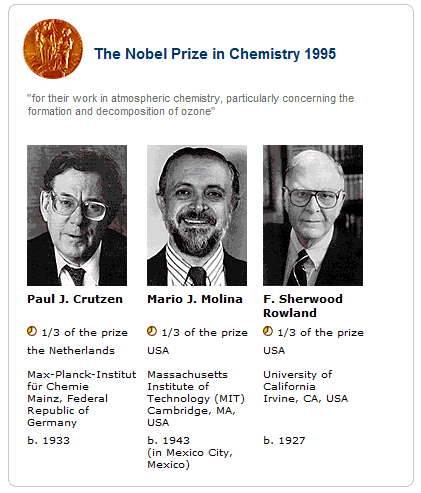|
News & Views item - April 2005 |
![]() When
the Lack of Greed is Good - A Case for Research for the Benefit of the World's
Population. (April 26, 2005)
When
the Lack of Greed is Good - A Case for Research for the Benefit of the World's
Population. (April 26, 2005)
"Sometimes the dominant animal on Earth just gets lucky."
That's the memorable opening to a chapter in Paul and Anne Ehrlich's One with Ninevah.
Freon is a trade name for a group of chlorofluorocarbons (CFCs). Freon replaced the highly toxic ammonia (NH3) as the gas of choice for use in the world's refrigeration equipment. With the exponential use of refrigerators and air conditioners following WWII the amount of CFCs used and in consequence leaked into the atmosphere rose comparably. Later CFCs found additional favour as the propellant in aerosol sprays thereby directly injecting CFCs into the atmosphere.
With James Lovelock's development of the electron capture gas chromatograph the quantitative determination of atmospheric CFCs became possible and Sherwood Rowland together with his post-doc Mario Molina undertook time series research to estimate the CFC concentrations. Ultimately they drew the conclusion that CFCs could be responsible for the destruction of the earth's UV shielding ozone (O3) layer some 13 - 50 kilometres above the Earth's surface.
In essence it is the ozone layer that allowed terrestrial life to evolve and allows it to survive in its current form.
According to the Ehrlichs' account Rowland and Molina copped considerable abuse from corporate interests, but in due course Joe Farman and his co-workers of the British Antarctic Survey "documented the thinning of the ozone shield over Halley Bay and Argentine Island. That received confirmation with the re-examination in 1983 of previously misinterpreted satellite data, and then in 1986 Susan Solomon and her team "showed beyond reasonable doubt that CFCs were the cause of the Antarctic's ozone hole.
The ozone is destroyed by compounds produced through the decomposition of CFCs. The use of CFCs was largely phased out by the 1987 Montreal Protocol. However, residual CFCs will be responsible for ozone destruction in polar regions at least until the mid 21st century. In fact news@nature.com reports:
A combination of climate change and pollution is chewing through Europe's ozone, researchers say. They have announced that the protective layer over northern and central Europe was thinner this season [2005] than it has been since measurements began 50 years ago.
In 1995 Rowland and Molina shared the Nobel Prize in Chemistry together with Paul Crutzen "for their work in atmospheric chemistry, particularly concerning the formation and decomposition of ozone"
